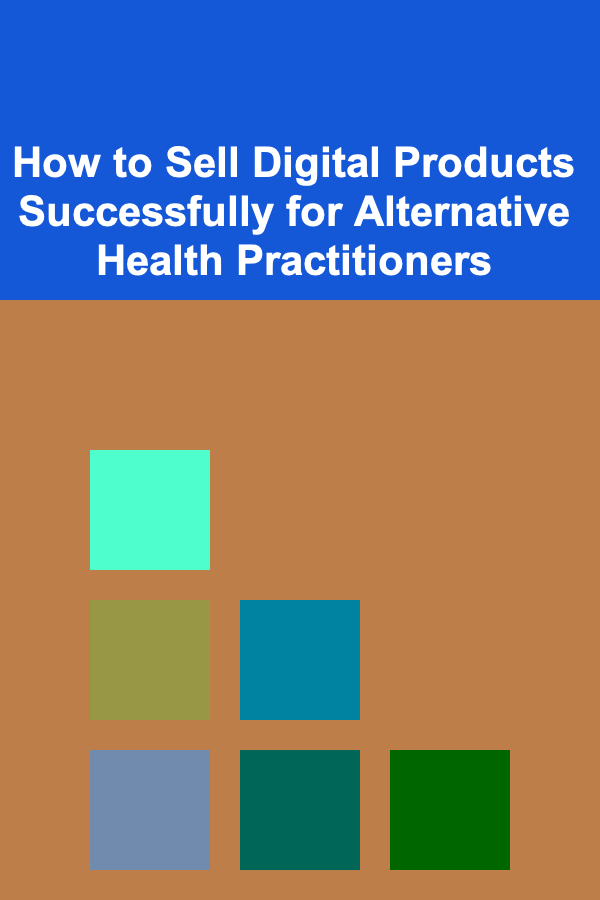
How to Sell Digital Products Successfully for Alternative Health Practitioners
ebook include PDF & Audio bundle (Micro Guide)
$12.99$8.99
Limited Time Offer! Order within the next:

In today's digital world, alternative health practitioners have a unique opportunity to expand their reach and offer valuable resources to a wider audience. Selling digital products---such as eBooks, courses, meditation guides, downloadable meal plans, and wellness templates---has become a profitable and sustainable revenue stream for many professionals in the alternative health space. These products not only help practitioners leverage their expertise but also allow them to impact a larger group of people, especially in a time when convenience and accessibility are key.
This actionable guide will provide a comprehensive, step-by-step approach for alternative health practitioners to successfully sell digital products online, from creating and marketing your products to scaling your sales for long-term success.
Step 1: Identify Your Target Audience
Understanding who your digital products are for is the first step to creating something that truly resonates. As an alternative health practitioner, your audience may consist of individuals seeking natural remedies, mindfulness practices, stress relief, weight loss solutions, or spiritual healing.
Here's how to define your target audience:
- Assess Their Needs: What pain points or challenges do your clients or followers face? Are they looking for solutions to anxiety, chronic pain, or healthy living? Tailoring your products to meet their specific needs will make them more attractive and useful.
- Consider Demographics: While your offerings may span various age groups and backgrounds, consider factors like gender, location, and lifestyle preferences. For example, a digital course focused on holistic weight loss may appeal to individuals looking to make long-term lifestyle changes, whereas a meditation guide might attract busy professionals looking for quick stress relief.
- Evaluate Their Learning Style: Do your target clients prefer reading, listening, or visual learning? This can influence whether you create an eBook, an audio course, a video course, or interactive worksheets.
Once you have a clear picture of your audience, you'll have the foundation for creating digital products that speak directly to their needs and preferences.
Step 2: Develop Your Digital Product Ideas
Now that you know your audience, it's time to decide which digital products to create. Your offerings should reflect your unique skills and expertise as an alternative health practitioner, while also being in high demand.
Here are a few popular types of digital products for alternative health practitioners:
- eBooks and Guides: Create written content that educates or guides your audience on a specific topic. This could be a guide on healing with herbs, a step-by-step manual for practicing mindfulness, or an eBook detailing nutrition for mental clarity.
- Online Courses and Workshops: Share your knowledge and skills in a more interactive format. This could be a video course on stress reduction techniques, a virtual workshop on chakra balancing, or a 30-day wellness challenge program.
- Meditation Audios and Podcasts: Meditation is a cornerstone of many alternative health practices. Record guided meditations, mindfulness sessions, or even sound healing sessions that your clients can download and practice anywhere.
- Printable Templates and Worksheets: Offer helpful downloadable resources like meal planners, daily wellness trackers, yoga routines, or affirmations. These products allow clients to integrate wellness practices into their daily lives easily.
- Membership Programs: For ongoing engagement, you might offer a subscription-based service that delivers exclusive content, such as monthly meditation videos, health tips, live Q&A sessions, or access to a supportive community.
- Healing or Wellness Plans: Customize and sell personalized health or wellness plans. These could include lifestyle changes, dietary adjustments, or self-care strategies, designed for specific conditions like stress, sleep disorders, or digestive health.
The key here is to create products that align with your skills, knowledge, and your audience's needs. The more specific and niche your offerings, the better chance you have of standing out in the crowded digital market.
Step 3: Create High-Quality Content
Once you've decided what digital products to offer, the next step is creating them. Whether you're designing an online course or writing an eBook, quality is paramount. Your digital products represent your expertise, and you want to ensure they provide value to your audience.
Here are some tips for creating high-quality content:
- Invest in Professional Tools: Whether you're creating video courses, designing PDFs, or recording audio, the tools you use can make a big difference in the quality of your product. Invest in a good microphone for recordings, user-friendly course creation software, and design tools for eBooks and PDFs.
- Break Down Complex Ideas: While your audience may be interested in alternative health, they may not be experts in the field. Break down your content into digestible, easy-to-understand chunks. Use clear language, simple graphics, and step-by-step instructions.
- Offer Value: Don't just create a product for the sake of selling. Ensure that your products provide tangible benefits to your customers. For instance, if you're offering a meditation guide, ensure it's well-researched and includes techniques that can produce real, measurable results.
- Test Your Products: Before launching, it's a good idea to test your products with a small group of clients or trusted colleagues. Ask for feedback on usability, clarity, and overall effectiveness. This feedback can help you refine your products before they go live.
- Design for User Experience: Digital products should be easy to navigate and visually appealing. This means choosing a clean design for your eBooks, ensuring your online courses are easy to follow, and using a well-organized platform for your membership content.
Step 4: Set Up a Professional Sales Platform
To sell your digital products, you'll need a platform to host and process transactions. There are many platforms out there that cater specifically to digital product sales. The key is to select one that fits your needs in terms of ease of use, flexibility, and payment options.
Some popular options include:
- Teachable or Thinkific: These platforms are great for hosting online courses and workshops. They allow you to upload videos, create quizzes, and offer a seamless user experience.
- Etsy: While traditionally a marketplace for handmade goods, Etsy is also an excellent platform for selling digital products, such as eBooks, downloadable planners, or printable resources.
- Shopify: If you want full control over your online store, Shopify provides an excellent platform for selling digital and physical products.
- Gumroad: A simple, no-frills platform that is perfect for selling downloadable items like eBooks or audio files. It's easy to set up and manage.
- Kajabi: This all-in-one platform helps you create, market, and sell your digital products. It offers robust tools for email marketing, course creation, and membership site management.
Ensure that whichever platform you choose, it's easy for both you and your customers to use. The buying process should be seamless, with clear payment options, easy navigation, and automated delivery of digital products after purchase.
Step 5: Market Your Digital Products
Once your digital products are ready and your sales platform is set up, it's time to market your offerings to your target audience. Here's how to build a successful marketing strategy:
- Leverage Social Media: Use platforms like Instagram, Facebook, and YouTube to share valuable content, tips, and teasers for your digital products. Engage with your followers regularly to build trust and showcase your expertise.
- Build an Email List: Offer free resources such as a downloadable guide, a free meditation session, or a newsletter in exchange for email sign-ups. Use email marketing to nurture your leads and promote your products.
- Collaborate with Influencers: Partner with other alternative health practitioners, influencers, or wellness bloggers to expand your reach. Influencers in the wellness community can provide social proof and help you attract new customers.
- Create Valuable Content: Start a blog, podcast, or YouTube channel to provide free value to your audience. By establishing yourself as an expert in your field, you'll naturally attract people who are interested in your digital products.
- Offer Discounts and Promotions: Run limited-time offers, bundle discounts, or seasonal sales to entice new customers. Early bird discounts or bonuses for first-time buyers can also generate excitement.
- Use Paid Ads: If you have a marketing budget, consider running paid ads on platforms like Facebook or Google to reach a broader audience. Target your ads to individuals interested in alternative health practices to ensure they reach the right people.
Step 6: Provide Exceptional Customer Support
Providing great customer support is essential to building long-term relationships with your clients. Here's how to ensure a positive customer experience:
- Respond Quickly: Answer any customer questions or concerns promptly. This is especially important if they are having trouble accessing their digital product or if they need assistance with a technical issue.
- Offer Clear Instructions: Provide clear, easy-to-follow instructions on how to access and use the products. This is crucial for products like courses or audio guides.
- Encourage Feedback: After a customer purchases your product, ask for their feedback. This will help you improve your future offerings and build stronger customer loyalty.
- Implement a Refund Policy: Offer a fair refund policy. This reduces the risk for customers and increases their confidence in purchasing from you.
Step 7: Scale and Expand Your Offerings
Once you've successfully launched your digital products and have a steady stream of sales, it's time to scale up:
- Create More Products: Diversify your product line. If you started with an eBook, consider expanding into online courses or meditation audio files.
- Automate Your Processes: Use tools like email marketing automation, scheduled social media posts, and sales funnels to automate aspects of your business.
- Monitor Analytics: Track your sales, website traffic, and customer engagement. Use this data to refine your marketing strategies and optimize your product offerings.
- Build a Community: Create a community around your brand, such as a Facebook group or a membership site, where customers can share experiences, ask questions, and support each other.
Conclusion
Selling digital products is an effective way for alternative health practitioners to generate passive income and scale their businesses. By identifying your target audience, creating high-quality content, and effectively marketing your products, you can establish a successful digital product business that serves a larger community while supporting your own professional growth.
Remember that success in digital product sales takes time, persistence, and continuous learning. By staying engaged with your audience and continually providing value, you'll not only sell more products but also position yourself as a trusted authority in the alternative health space.
Reading More From Our Other Websites
- [Home Party Planning 101] How to Throw an Allergy-Friendly Home Party: A Comprehensive Guide
- [Home Maintenance 101] How to Fix a Broken Window Screen and Prevent Future Damage: An Expert's Advice
- [Rock Climbing Tip 101] The Art of Traditional Climbing: Mastering Gear Placement and Route Reading
- [Organization Tip 101] How to Organize Your Memory Box for Keepsakes
- [Home Cleaning 101] How to Clean Your Home's Baseboards and Moldings
- [Sewing Tip 101] Top 10 Must-Have Sewing Needles for Hobbyists and Professionals
- [Personal Investment 101] How to Choose an Online Broker to Maximize Your Investment Strategy
- [Personal Care Tips 101] How to Choose a Mascara That Will Not Irritate Your Eyes
- [Organization Tip 101] DIY Quartz Countertop Repair: Tips for Successful Restoration
- [Digital Decluttering Tip 101] The Science of Screen Time: Balancing Efficiency and Burnout

Beginner's Guide to Building a Personal Brand
Read More
How to Build an Emergency Fund Within Your Home Budget
Read More
How to Reflect on Your Study Habits for Continuous Improvement
Read More
How to Understand Your Credit Report and Its Impact on Budgeting
Read More
How to Use Folders and Labels for Digital Files
Read More
10 Tips for Mental Toughness in Basketball
Read MoreOther Products

Beginner's Guide to Building a Personal Brand
Read More
How to Build an Emergency Fund Within Your Home Budget
Read More
How to Reflect on Your Study Habits for Continuous Improvement
Read More
How to Understand Your Credit Report and Its Impact on Budgeting
Read More
How to Use Folders and Labels for Digital Files
Read More